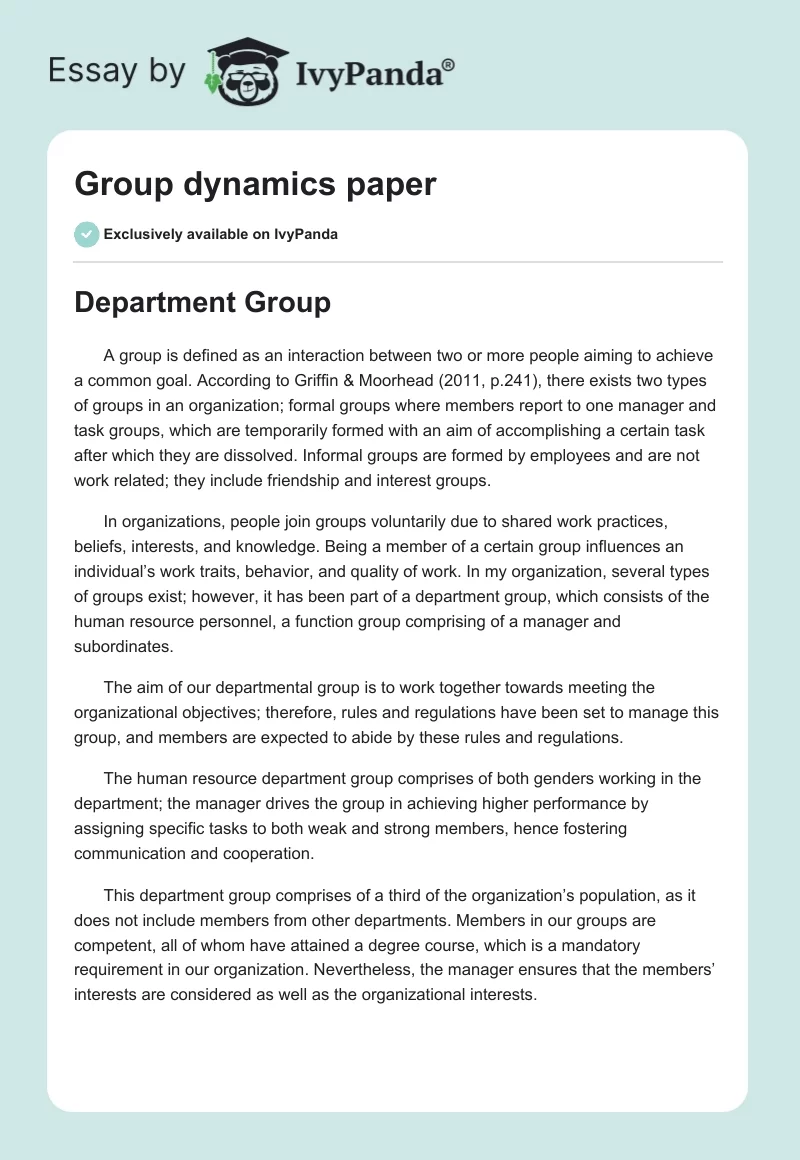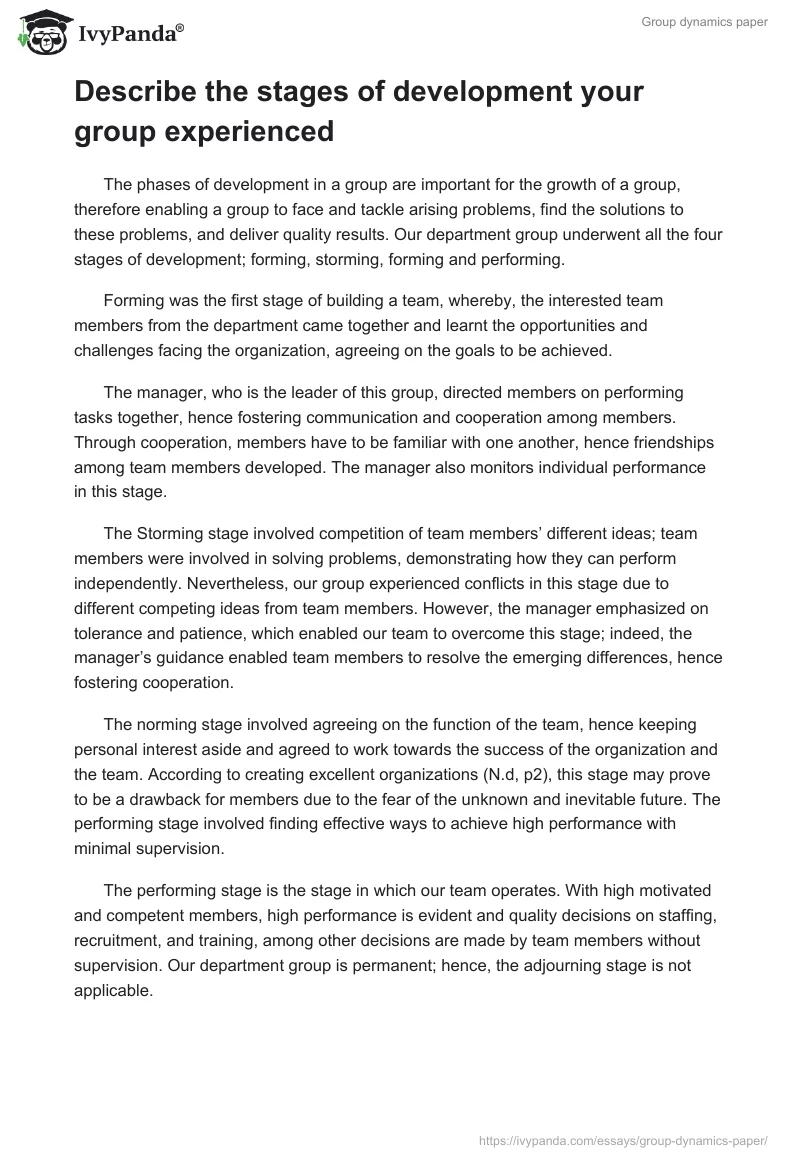Department Group
A group is defined as an interaction between two or more people aiming to achieve a common goal. According to Griffin & Moorhead (2011, p.241), there exists two types of groups in an organization; formal groups where members report to one manager and task groups, which are temporarily formed with an aim of accomplishing a certain task after which they are dissolved. Informal groups are formed by employees and are not work related; they include friendship and interest groups.
In organizations, people join groups voluntarily due to shared work practices, beliefs, interests, and knowledge. Being a member of a certain group influences an individual’s work traits, behavior, and quality of work. In my organization, several types of groups exist; however, it has been part of a department group, which consists of the human resource personnel, a function group comprising of a manager and subordinates.
The aim of our departmental group is to work together towards meeting the organizational objectives; therefore, rules and regulations have been set to manage this group, and members are expected to abide by these rules and regulations.
The human resource department group comprises of both genders working in the department; the manager drives the group in achieving higher performance by assigning specific tasks to both weak and strong members, hence fostering communication and cooperation.
This department group comprises of a third of the organization’s population, as it does not include members from other departments. Members in our groups are competent, all of whom have attained a degree course, which is a mandatory requirement in our organization. Nevertheless, the manager ensures that the members’ interests are considered as well as the organizational interests.
Describe the stages of development your group experienced
The phases of development in a group are important for the growth of a group, therefore enabling a group to face and tackle arising problems, find the solutions to these problems, and deliver quality results. Our department group underwent all the four stages of development; forming, storming, forming and performing.
Forming was the first stage of building a team, whereby, the interested team members from the department came together and learnt the opportunities and challenges facing the organization, agreeing on the goals to be achieved.
The manager, who is the leader of this group, directed members on performing tasks together, hence fostering communication and cooperation among members. Through cooperation, members have to be familiar with one another, hence friendships among team members developed. The manager also monitors individual performance in this stage.
The Storming stage involved competition of team members’ different ideas; team members were involved in solving problems, demonstrating how they can perform independently. Nevertheless, our group experienced conflicts in this stage due to different competing ideas from team members. However, the manager emphasized on tolerance and patience, which enabled our team to overcome this stage; indeed, the manager’s guidance enabled team members to resolve the emerging differences, hence fostering cooperation.
The norming stage involved agreeing on the function of the team, hence keeping personal interest aside and agreed to work towards the success of the organization and the team. According to creating excellent organizations (N.d, p2), this stage may prove to be a drawback for members due to the fear of the unknown and inevitable future. The performing stage involved finding effective ways to achieve high performance with minimal supervision.
The performing stage is the stage in which our team operates. With high motivated and competent members, high performance is evident and quality decisions on staffing, recruitment, and training, among other decisions are made by team members without supervision. Our department group is permanent; hence, the adjourning stage is not applicable.
Analyze the structure of your selected group and the effect that this structure has on the effectiveness of the group
According to Tuckman (1965, p.385), a group structure is related to the pattern of interpersonal relationship, which yields to interpersonal group behaviors. Nevertheless, our human resource department group is a formal group within a large organization. It is well equipped with competent personnel who handle employee’s issues raging from recruiting, training, discipline and employee welfare issues like Medicare among other roles.
This group is headed by a manager who is the leader and oversees the group’s activities; it is a sensitive department as confidentiality of employees’ details is highly recommended. The superiors assist this group by ensuring that they consider the proposed decisions of team members, hence involving the members in the decision making process.
With the support provided by the manager and superiors, the group is well motivated, performance is high, and it works under minimal supervision. Outstanding performances are rewarded by the management; hence boosting the employees’ morale. In addition, the democratic type of leadership in this group creates loyalty in team members. According to Hartley (2007, p.1), motivating team members enables them to be loyal to the team, hence retaining them and maintaining a competitive advantage over other groups.
Explain the dynamics of group behavior within your selected group
Being part of a group involves interacting with other team members, who can influence the behavior of an individual. In addition, the norms and attitudes of a group can influence an individual’s behavior. Group norms are important in a group, as they portray the image of a group.
A group cohesiveness impacts on communication, members’ satisfaction, members’ performance, and the group’s willingness to change. Team dynamics also influence the reaction of a team and its behavior. In our team, friendships have been developed, hence fostering communication, which boosts cooperation and commitment to the team.
Therefore, this group has the norm of communicating, fostered by friendships within the team. The type of leadership used in a group determines the behavior of a group; the democratic leadership revealed in this group has yielded motivated team members who are productive and loyal to the group, thus requiring minimal supervision.
Effective problem solving procedures enable the group members to solve problems fast and effectively; indeed, brainstorming is common in this group, hence generating many ideas, which yield to decision-making. Participative behavior is therefore evident in this department group, as all ideas are put into consideration.
The set norms in this group enable members to keep to certain behavior standards. They include performance norms that determine how fast members are required to work and reward allocation norms that determine how rewards will be bestowed upon group members, which could apply to each member’s contribution. Therefore, norms determine the group’s behavior, shaping members into responsible and accountable individuals.
Analyze the effect that your selected group has had on you concerning the following concepts: group polarization, conformity, and groupthink
According to Krizan & Baron (2007, p.193), group polarization entails making extreme decisions when in a group, hence bringing members of a group towards a common view. Nevertheless, belonging to a group has had an effect on my view of several concepts. Group polarization can bring about competition in contribution of ideas such that, some members will go to the extreme of exaggerating their point even when their point is extreme, thereafter putting the group at a risk, as they believe the risk will be shared.
However, the conservative members only make decision while putting the group interests first; they avoid risky decisions that could affect the group. Therefore, members should consider their decisions before supporting them, especially if they are unsure of the effects of such decisions. In our group, such cases have been evident; hasty decisions that force the entire group to face the consequences have been made, which also affect the organization.
Conformity entails matching of attitudes, behaviors, and beliefs to what an individual’s view is normal in the group. However, some behaviors can be viewed as either beneficial or negative conformity, therefore influencing formation of norms. Nevertheless, in order to fit in a group, some change in behavior and belief may be required.
Therefore, conformity is associated with group pressures, which result to change. Having been in a group, conformity is necessary at times, for instance, if an individual has an introvert personality, he has to change and become social in order to cope with other members in terms of communication and cooperation.
Groupthink is a mode of thinking that occurs when group members minimize conflicts by reaching an effective decision; however, individual creativeness and independent thinking is lost due to over-reliance in groupthink.
My group however has rules concerning decision making whereby, the group is not allowed to make hasty decisions that would cost the group and the organization dearly. Groupthink could lead to irrational decisions that ignore the moral and ethical consequences for these decisions; however, individual thinking should be encouraged. When different ideas are considered, quality decisions are made.
Conclusion
An organization can be classified as a group, as it consists of individuals who work towards achieving similar goals; they are connected by the same culture and norms. Groups also affect an individual’s behavior, since an individual adapts to the culture and norms of an organization.
Therefore, in such a setting, a leader is required, who must covey effective leadership; effective leadership involves considering the needs of employees. Motivation is an important concept, as it affects an individual’s behavior. When employees are motivated, their performance level increases, and in return, organization productivity increases.
References
Creating excellent organizations. Leadership development resources. Web.
Griffin, R. & Moorhead, G. (2011). Organizational Behavior. OH: Cengage Learning Publisher. Web.
Hartley, S. (2007). Motivating workers. Businessdate, 15(1), 1-3. Web.
Krizan, Z. & Baron, R. (2007). Group polarization and choice-dilemmas: How important is self-categorization? European Journal of Social Psychology, 37(1), 191–201. Web.
Tuckman, B. (1965). Developmental sequence in small groups. Psychological reflection, 63(6), 384-399. Web.


